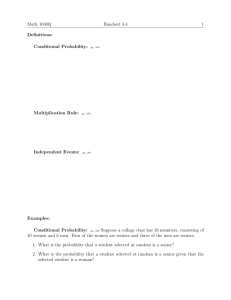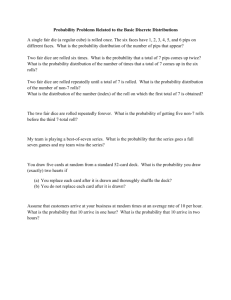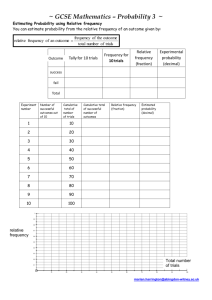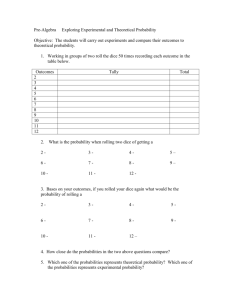Statistics 116 - Fall 2004 Theory of Probability Practice Midterm # 1
advertisement
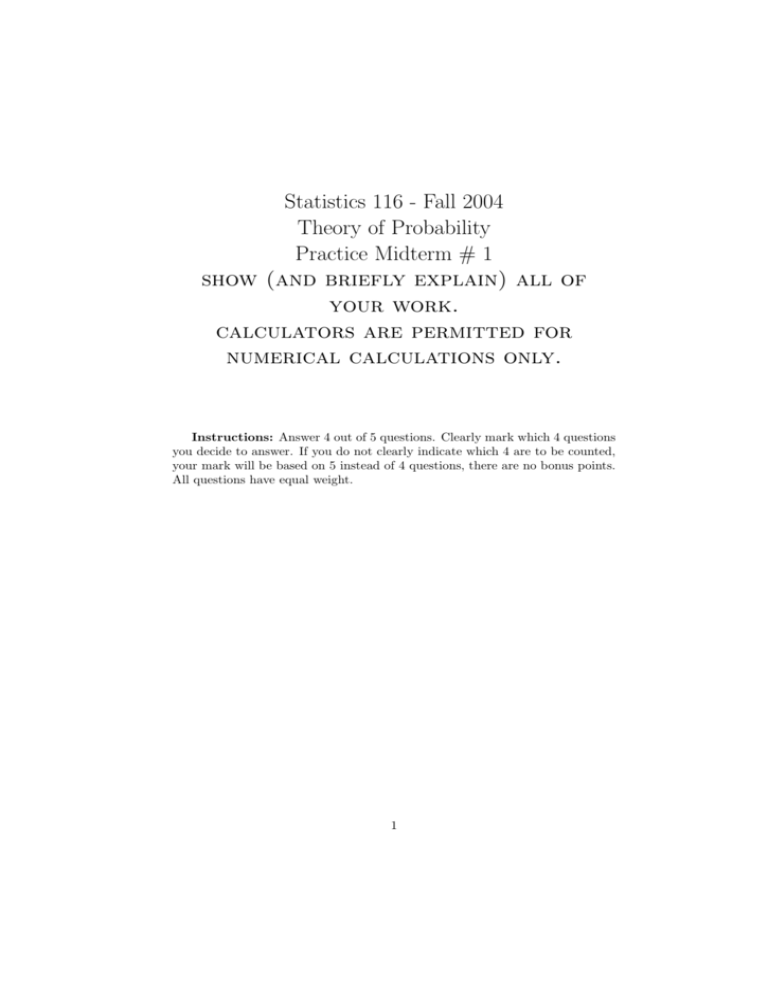
Statistics 116 - Fall 2004
Theory of Probability
Practice Midterm # 1
show (and briefly explain) all of
your work.
calculators are permitted for
numerical calculations only.
Instructions: Answer 4 out of 5 questions. Clearly mark which 4 questions
you decide to answer. If you do not clearly indicate which 4 are to be counted,
your mark will be based on 5 instead of 4 questions, there are no bonus points.
All questions have equal weight.
1
Q. 1) The second Earl of Yarborough is reported to have bet at odds of 1000
to 1 that a hand of 13 cards (out of a deck of 52) would contain at least
one card that is ten or higher. (By ten or higher we mean that a card is
either a ten, jack, queen, king or ace.) What is the probability that the
Earl wins this bet?
Solution: We compute the probability that the Earl loses this bet. The
Earl loses his bet if his hand contains no cards above 9, or that every card
in his hand has
value 9 or less. There are 32 such cards52(A’s
are high), so
there are 32
hands
with
all
values
of
9
or
less
out
of
13
13 possible hands.
The probability that he loses is:
32
13
52
13
' 0.000547
and the probability that he wins is 99.95%.
Q. 2) A deck of 52 cards is shuffled and then divided into two halves of 26 cards
each. A card is drawn from one of the halves; it turns out to be an ace.
The ace is then placed in the second half-deck. This half is then shuffled,
and a card is drawn from it. Compute the probability that the card drawn
is an ace.
Solution: Let
E = {first card drawn is an A}
F = {second card drawn is the original A drawn in the first round}
G = {second card drawn is an A}
We must compute
P (G|E) = P (G|F ∩ E) × P (F |E) + P (G|F c ∩ E) × P (F c |E)
1
3
26
=1×
+
× .
27 51 27
Alternate solution:
Number the A’s 1 through 4 and let Ai be the event that the i-th ace was
drawn on the first hand. You don’t have to number the A’s but it helps
later. Keeping G and E as above, for i = 1, . . . , 4
P (G|E) = P (G|Ai ).
That is, the (conditional) probability the second card drawn is an A, given
the first card was an A is the same as the (conditional) probability that
second card drawn is an A, given the first card drawn was Ai .
Let Fj , j = 0, 1, 2, 3, 4 be the event that the second half of the deck has j
aces after the initial split.
2
Then, choosing A1 as our first draw
P (G|E) = P (G|A1 )
=
4
X
P (G|A1 ∩ Fj )P (Fj |A1 )
j=0
=
3
X
P (G|A1 ∩ Fj )P (Fj |A1 )
j=0
because P (F4 |A1 ) = 0.
Now,
j+1
27
P (G|A1 ∩ Fj ) =
and
P (Fj |A1 ) =
3
j
48
26−j
51
3
.
Therefore,
3
0
1
P (G|E) =
27
3
27
48
3
2 1
26
+
51
27
3
3 48
4
2 24
+
51
27
3
48
25
51
3
3 48
3 23
,
51
3
which agrees with the first solution.
Q. 3) Let Pn denote the probability that n independent trials with probability
of success p result in an even number of successes (0 being considered an
even number).
(a) Show that
Pn = p · (1 − Pn−1 ) + (1 − p) · Pn−1 ,
n ≥ 1.
(b) Use this to prove, by induction, that
Pn =
1 + (1 − 2p)n
.
2
Solution:
(a) Define the event
En1 = {first trial is a success}
En = {an even number of successes occur}.
3
We must compute
Pn = P (En )
= P (En |En1 ) × P (En1 ) + P (En |En1 c ) × P (En1 c )
= P (En |En1 ) × p + P (En |En1 c ) × (1 − p).
Now,
En ∩ En1 = {first event is a success AND there are an odd
number of successes in the last n − 1 trials}
En ∩ En1 c = {first event is a failure AND there are an even
number of successes in the last n − 1 trials}.
Therefore
P (En |En1 ) = 1 − Pn−1
P (En |En1 c ) = Pn−1
and
Pn = p × (1 − Pn−1 ) + (1 − p) × Pn−1 = p + (1 − 2p) × Pn−1 .
(b) To prove the relation by induction we must first prove it true for
n = 1. Clearly, P0 = 1 because if we perform 0 trials we must have
0 successes. The recrusion relation tells us that
P1 = p + (1 − 2p) × P0 = 1 − p.
On the other hand, we know P1 = 1 − p because if we perform only
1 trial, then the only way to obtain an even number of successes is
to obtain 0 successes and this occurs with probability 1-p.
Next, we have to show that if the relation is true for n = k then it is
also true for n = k + 1. That is, we must decide whether
1 + (1 − 2p)k
1 + (1 − 2p)k+1 ?
= p + (1 − 2p) ×
.
2
2
Simplifying the righthand side we see that
p+(1−2p)×
1 + (1 − 2p)k
2p + 1 − 2p + (1 − 2p)k+1
1 + (1 − 2p)k+1
=
=
,
2
2
2
which is what we wanted to prove. Therefore, by induction, we have
proven that
1 + (1 − 2p)n
Pn =
.
2
4
Q. 4) In the game craps, two dice are rolled and certain bets are made on the outcome of these rolls. A casino has accused a particular gambler of secretly
replacing the usual fair dice with two identical weighted dice, where the
weights are suspected to be (1/4, 1/4, 1/6, 1/6, 1/12, 1/12) (i.e. the probability that a “1” is rolled is 1/4 and the probability that a “4” is rolled is
1/6) as opposed to the usual weights of (1/6, 1/6, 1/6, 1/6, 1/6, 1/6). You,
an inspector, are sent in to investigate.
(a) If the weighted dice (with weights as above) are rolled, what is the
probability that a pair is rolled?
(b) Suppose that, from experience, you know there is a 5% probability
that the casino’s allegation is true. To test the claim, you decide to
roll the two possibly weighted dice 20 times and count the number
of pairs rolled. If you rolled 6 pairs out of 20 possible, what is the
conditional probability that the dice you rolled were weighted?
(a) If we use the weighted dice, we have
P (pair) = P ({(1, 1) ∪ (2, 2) ∪ (3, 3) ∪ (4, 4) ∪ (5, 5) ∪ (6, 6)})
2 2 2 2 2 2
1
1
1
1
1
1
+
+
+
+
+
=
4
4
6
6
12
12
7
=
.
36
(b) Let DW be the event that the dice are weighted. We are given
P (DW ) = 0.05 and are asked to compute
P (DW |E) =
P (E|DW )P (DW )
c )P (D c )
P (E|DW )P (DW ) + P (E|DW
W
where
E = {6 pairs were rolled out of a possible 20}.
Rolling the pair of dice 20 times consists of 20 independent trials, with
probability of success 7/36 when the dice are weighted as above and
with probability of success 1/6 when the dice are fair. In Lecture #10
we saw that the probability there are k successes in n independent
trials each with probability of success p is
n k
p (1 − p)n−k .
k
Therefore,
6 14
7
29
36
36
6 14
20
1
5
c
P (E|DW
)=
6
6
6
P (E|DW ) =
5
20
6
and
P (DW |E) =
7 6
36
7 6 29 14
× 0.05
36
36
6 5 14
14
29
× 0.05 + 16
36
6
× 0.95
.
Q. 5) A family has n ≥ 1 children with probability α · pn where α ≤ (1 − p)/p.
(a) What proportion of families have no children?
(b) Suppose each child, independently of the others, is equally likely to
be a boy or a girl. What proportion of families consists of k boys
(and any number of girls)?
Solution:
(a) If Y is a random variable representing the number of children of a
“typical” family , then we are asked to compute
P (Y = 0)
given the information that, for n ≥ 1
P (Y = n) = α · pn .
We know that
P (Y = 0) = 1 − P (Y ≥ 1) = 1 −
∞
X
αpn = 1 − α
n=1
p
.
1−p
(b) Let X represent the number of boys in a “typical” family then we
know that
n 1
P (X = k|Y = n) =
.
k 2n
This is because we know that conditional on a family having n children the event that any particular child in this family is a girl or a
boy is independent of all of the other children and has probability
1/2. Therefore, the probability there are k boys given there are n
children is equal to the probability that there are k successes in n
independent trials which, as we saw before was
n 1 1
n 1
=
.
k 2k 2n−k
k 2n
Therefore,
P (X = k) =
∞
X
n=k
∞ n
X
n
p
P (X = k|Y = n)P (Y = n) =
α
.
2
k
n=k
6
